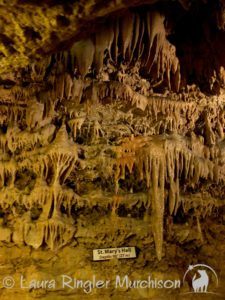
After Christmas and before the New Year, my husband, daughter, and I took a little road trip to San Antonio. Our little girl could not remember her first road trip there and we wanted to go during the holidays because the lights are so magical on the river. On our return, my husband had the brilliant idea to visit Natural Bridge Caverns. I had been before with my parents and also once with my husband, but realized our little one had never seen them and six seemed like a good age. She adores science and we all love geology so we hoped she would love it. The outside temperature was in the teens, which is cold for the southern part of Texas. As we waited in line, I felt like all the other tourists that stood there shivering and huddled against each other were questioning my sensibility as a mother. She and I, both hot natured, stood in only long sleeves with no coat. After a five minute wait our group began the slow descent into the caves. Discovered in 1960 by a group of four college students, the natural limestone bridge extends 60 feet. The average temperature inside is 70 degrees but I would submit it is a great deal warmer with the humidity. And my little family does not take heat well, the hubs included, despite us all being natural Texans. The Natural Bridge Caverns are the largest known commercial caverns in Texas, located in the Hill Country. Turns out the humidity rate is 99 percent and no one seemed to be giving me the side-eye as they all quickly worked to divest themselves of coats, hats, and scarves, which they now would have to carry for the next hour. The deepest part of our tour was 180 feet below the surface, and our entire journey was paved with the slick, slow trickle of rainwater traveling though layers of rock as it had for millennia. The water flows and drips, causing the formations to retain a waxy luster which I tried to capture in my pictures. I explained to my little one about stalactites versus stalagmites, and much of our tour centered around her trying to pronounce the difference as well as to remember them. I am proud to say by the end she had it somewhat mastered. I also noted some of the adults had rings of sweat around their shirts as my little one continued comfortably upon her scientific quest. Before leaving the last “room” in the caverns they had cleverly (and thoughtfully) set up water fountains produced by the cave’s own natural water. It was wonderful! The American writer and nauturalist Diane Ackerman said:
“Just as our ancient ancestors drew animals on cave walls and carved animals from wood and bone, we decorate our homes with animal prints and motifs, give our children stuffed animals to clutch, cartoon animals to watch, animal stories to read.”
Our little one was crushed we did not see any bats along our tour but the guides did point out with their flashlights where a bunch of bat dung hung copiously and somewhat gracefully, way up high and far removed from where we were. She insisted upon taking a plush animal with her and I thought back to how often I had done the same as a child. I have always connected with animals and I was lucky enough to marry a man who loves them just as much. We are rearing a child who lives with wolf hybrids, cats, mice, turtles, and koi. Neither her father nor I were particularly surprised when our little one begged to have a plush bat from their gift shop. Steering her toward a less expensive mouse, we realized that, like us, she had gone bats in the caves.
